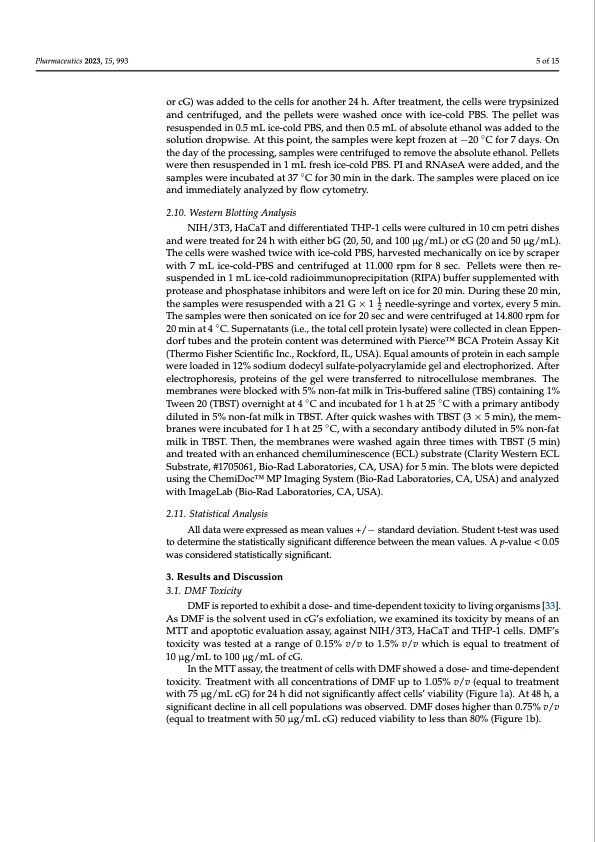
PDF Publication Title:
Text from PDF Page: 005
Pharmaceutics 2023, 15, 993 5 of 15 or cG) was added to the cells for another 24 h. After treatment, the cells were trypsinized and centrifuged, and the pellets were washed once with ice-cold PBS. The pellet was resuspended in 0.5 mL ice-cold PBS, and then 0.5 mL of absolute ethanol was added to the solution dropwise. At this point, the samples were kept frozen at −20 ◦C for 7 days. On the day of the processing, samples were centrifuged to remove the absolute ethanol. Pellets were then resuspended in 1 mL fresh ice-cold PBS. PI and RNAseA were added, and the samples were incubated at 37 ◦C for 30 min in the dark. The samples were placed on ice and immediately analyzed by flow cytometry. 2.10. Western Blotting Analysis NIH/3T3, HaCaT and differentiated THP-1 cells were cultured in 10 cm petri dishes and were treated for 24 h with either bG (20, 50, and 100 μg/mL) or cG (20 and 50 μg/mL). The cells were washed twice with ice-cold PBS, harvested mechanically on ice by scraper with 7 mL ice-cold-PBS and centrifuged at 11.000 rpm for 8 sec. Pellets were then re- suspended in 1 mL ice-cold radioimmunoprecipitation (RIPA) buffer supplemented with protease and phosphatase inhibitors and were left on ice for 20 min. During these 20 min, the samples were resuspended with a 21 G × 1 12 needle-syringe and vortex, every 5 min. The samples were then sonicated on ice for 20 sec and were centrifuged at 14.800 rpm for 20 min at 4 ◦C. Supernatants (i.e., the total cell protein lysate) were collected in clean Eppen- dorf tubes and the protein content was determined with PierceTM BCA Protein Assay Kit (Thermo Fisher Scientific Inc., Rockford, IL, USA). Equal amounts of protein in each sample were loaded in 12% sodium dodecyl sulfate-polyacrylamide gel and electrophorized. After electrophoresis, proteins of the gel were transferred to nitrocellulose membranes. The membranes were blocked with 5% non-fat milk in Tris-buffered saline (TBS) containing 1% Tween 20 (TBST) overnight at 4 ◦C and incubated for 1 h at 25 ◦C with a primary antibody diluted in 5% non-fat milk in TBST. After quick washes with TBST (3 × 5 min), the mem- branes were incubated for 1 h at 25 ◦C, with a secondary antibody diluted in 5% non-fat milk in TBST. Then, the membranes were washed again three times with TBST (5 min) and treated with an enhanced chemiluminescence (ECL) substrate (Clarity Western ECL Substrate, #1705061, Bio-Rad Laboratories, CA, USA) for 5 min. The blots were depicted using the ChemiDocTM MP Imaging System (Bio-Rad Laboratories, CA, USA) and analyzed with ImageLab (Bio-Rad Laboratories, CA, USA). 2.11. Statistical Analysis All data were expressed as mean values +/− standard deviation. Student t-test was used to determine the statistically significant difference between the mean values. A p-value < 0.05 was considered statistically significant. 3. Results and Discussion 3.1. DMF Toxicity DMF is reported to exhibit a dose- and time-dependent toxicity to living organisms [33]. As DMF is the solvent used in cG’s exfoliation, we examined its toxicity by means of an MTT and apoptotic evaluation assay, against NIH/3T3, HaCaT and THP-1 cells. DMF’s toxicity was tested at a range of 0.15% v/v to 1.5% v/v which is equal to treatment of 10 μg/mL to 100 μg/mL of cG. In the MTT assay, the treatment of cells with DMF showed a dose- and time-dependent toxicity. Treatment with all concentrations of DMF up to 1.05% v/v (equal to treatment with 75 μg/mL cG) for 24 h did not significantly affect cells’ viability (Figure 1a). At 48 h, a significant decline in all cell populations was observed. DMF doses higher than 0.75% v/v (equal to treatment with 50 μg/mL cG) reduced viability to less than 80% (Figure 1b).PDF Image | Green Exfoliation of Graphene

PDF Search Title:
Green Exfoliation of GrapheneOriginal File Name Searched:
pharmaceutics-15-00993.pdfDIY PDF Search: Google It | Yahoo | Bing
Salgenx Redox Flow Battery Technology: Power up your energy storage game with Salgenx Salt Water Battery. With its advanced technology, the flow battery provides reliable, scalable, and sustainable energy storage for utility-scale projects. Upgrade to a Salgenx flow battery today and take control of your energy future.
| CONTACT TEL: 608-238-6001 Email: greg@infinityturbine.com | RSS | AMP |